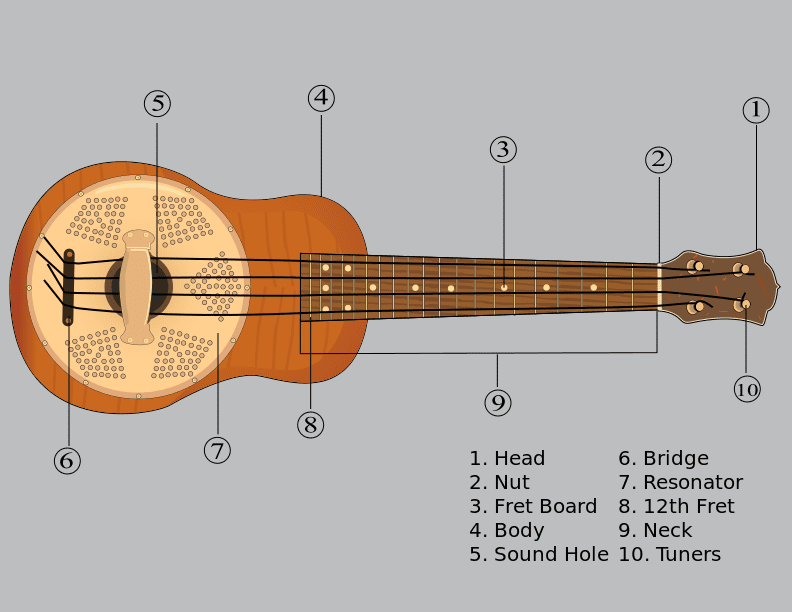
An excellent starting point for all beginners is to learn their notes on the ukulele. As you learn to navigate the notes on the fretboard, you’ll build an understanding of the basics – so you can start playing tunes in no time!
Once you’ve mastered the individual notes, you can use them to build chords, and chords quickly turn into songs. These individual ukulele notes are also necessary for learning how to play licks or riffs.
In this article, we’ll discuss different ways to tune your ukulele, and the chromatic scale as it applies to learning ukulele notes. Then we’ll list a ukulele note chart for each of the most common tunings on the ukulele.
But before we start, let’s understand a little bit more about what is a ukulele?
What is the History of the Ukulele?
The ukulele has a history that dates back to the 1800s, when Portuguese immigrants came to the Hawaiian Islands to work on the sugarcane plantations. Here, Hawaiian locals feel in love with their small guitars or machetes that they use to relax after a hard day or work in the fields.
Hawaiians named their version of the four-string instrument a ukulele, which literally translates into jumping flea as they adored the way musicians’ hands jumped across the strings as they played.
Today, the ukulele is used by both novice and professional musicians to play a variety of music, ranging from modern tunes to older favorites such as Israel Kamakawiwo’ole’s “Somewhere over the Rainbow.”
Now that you know a little more about the ukulele, let’s take a look at the notes of this favorite instrument in this comprehensive guide.
A Comprehensive Guide to Ukulele String Notes
How Tuning Affects Notes
There are multiple ways to tune a ukulele. We’ll start by explaining ukulele notes for standard tuning – the most common way to tune a ukulele that most beginners start with. It’s important to understand that other tunings will alter the notes on the fretboard.
Standard tuning for the ukulele is G-C-E-A. The G is the “top” string, (the one that is closest to your face while holding the ukulele), and then you have C, E, A in descending order.
These are the notes the strings will play when you play them “open,” in other words, when you play the string without any fingers on the fretboard. For example, strumming the G string alone will make a G note.
Frets on the Ukulele
You should also understand some of the basic parts of the ukulele before playing notes. A fret on the ukulele (also found on guitars) is a raised line that goes across the neck of the instrument.
Ukulele frets are markers that help you find the notes on the fretboard, AKA the “neck” of the instrument. The fretboard is typically played with the left hand. When playing a note, you’ll want to place your finger as close the fret as possible, without being directly on the fret.
Check out the diagram below to get more familiar with the different parts of the ukulele –

Understanding the Chromatic Scale
Each note that you’ll learn to play on the ukulele will be a part of what is known as the chromatic scale. This scale consists of the 12 notes standard in Western style music.
You may have heard the chromatic scale explained in the “do-re-me-fa-so-la-ti-do” song, from the movie The Sound of Music. It’s also commonly used as a teaching tool in elementary music classes.
This 12 note set starts with seven “pure notes.” The pure notes of the scale are: A – B – C – D – E – F – G
In between most of these notes there is a sharp and flat. Together, they complete the 12 note set that is described as an “octave.” Once you complete the 12 notes, you’ll start over with the same notes, just an octave higher or lower.
On the ukulele, each fret is only “half a step,” or half a note, apart. The in-between notes are named with sharps (#) and flats (b). A sharp is half a step up, and a flat is half a step down.
For example, a “Bb” (or “B flat”) is half a step down from the B note, but not yet an A. An “F#” (or “F sharp”) is half a step up from F, but not get a G.
With sharps and flats added in, the scale looks like this: A – A#/Bb – B – C – C#/Db – D – D#/Eb – E – F – F#/Gb – G – G#/Ab
Although the half steps are described as either “sharp” or “flat,” they are essentially the same note. In other words, A# and Bb are the same note.
Most of these notes tend to be described more often by one name than the other; Bb is more common than A# for example. However, both names are technically correct.
You’ll notice that there are no enharmonic notes (flats or sharps) between notes B and C, or E and F. This can be confusing, but one easy way to remember the difference is is that B/C and E/F are always “neighbors.”
Ukulele Note Chart for Standard Tuning
Now that you understand some ukulele strings notes basics, let’s get started with the specific notes on the fretboard. Below, we’ll explain all the ukulele notes (on the chromatic scale) on each string of the instrument.
Keep in mind that each string loops through the chromatic scale, just starting at a different spot. Below are the notes for each fret, on each string. The order starts with the first fret, nearest to the head of the ukulele, and then moves toward the body.
The G String
G – G#/Ab – A – A#/Bb – B – C – C#/Db – D – D#/Eb – E – F – F#/Gb
The C String
C – C#/Db – D – D#/Eb – E – F – F#/Gb – G – G#/Ab – A – A#/Bb – B
The E String
E – F – F#/Gb – G – G#/Ab – A – A#/Bb – B – C – C#/Db – D – D#/Eb
The A String
Bb – B – C – C#/Db – D – D#/Eb – E – F – F#/Gb – G – G#/Ab – A
Ukulele Notes for Alternate Tunings
While the standard and most common tuning for the ukulele is G-C-E-A, there are alternate tunings you can use as you advance in your playing. Remember that if the ukulele is tuned differently, the notes on the fretboard will change.
Below are the notes for two common alternate ukulele tunings. These tunings are also on the chromatic scale, but each string will start in a different place along the loop.
D-G-B-E Tuning
D String
D#/Eb – E – F – F#/Gb – G – G#/Ab – A – A#/Bb – B – C – C#/Db – D
G String
G#/Ab – A – A#/Bb – B – C – C#/Db – D – D#/Eb – E – F – F#/Gb – G
B String
C – C#/Db – D – D#/Eb – E – F – F#/Gb – G – G#/Ab – A – A#/Bb – B
E String
F – F#/Gb – G – G#/Ab – A – A#/Bb – B – C – C#/Db – D – D#/Eb – E
A-D-F#-B Tuning
A String
A#/Bb – B – C – C#/Db – D – D#/Eb – E – F – F#/Gb – G – G#/Ab – A
D String
D#/Eb – E – F – F#/Gb – G – G#/Ab – A – A#/Bb – B – C – C#/Db – D
F# String
G – G#/Ab – A – A#/Bb – B – C – C#/Db – D – D#/Eb – E – F – F#/Gb
B String
C – C#/Db – D – D#/Eb – E – F – F#/Gb – G – G#/Ab – A – A#/Bb – B
More Ukulele Note Charts
If you would like to learn more about ukulele notes or download a ukulele note chart, check out the following resources:
Want to take your playing skills a step further? Try the free online ukulele classes at TakeLessons Live, or look for a local ukulele teacher near you for private lessons.
Guest Author: Wendy Parish has played ukulele and performed as part of the group Britches & Hose since 2012, also the year she started working as a freelance writer.
Jessica Dais
![A Beginner's Guide to Ukulele Notes [Charts Included]](/_next/image?url=https%3A%2F%2Ftakelessons.com%2Fblog%2Fwp-content%2Fuploads%2F2018%2F11%2FA-Beginners-Guide-to.png&w=3840&q=75)